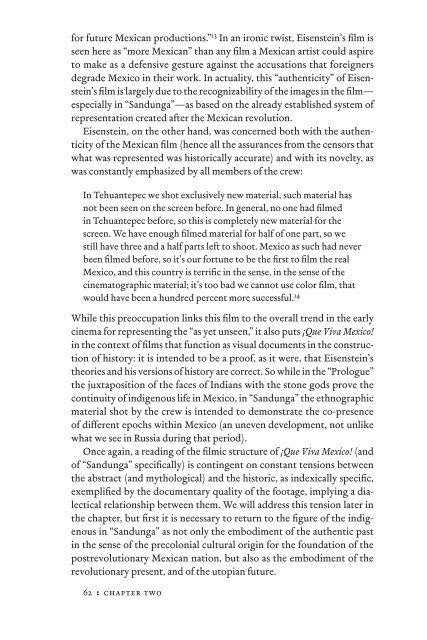In Excess: Sergei Eisentein's Mexico - Cineclub
In Excess: Sergei Eisentein's Mexico - Cineclub
In Excess: Sergei Eisentein's Mexico - Cineclub
Create successful ePaper yourself
Turn your PDF publications into a flip-book with our unique Google optimized e-Paper software.
for future Mexican productions.” 13 <strong>In</strong> an ironic twist, Eisenstein’s fi lm is<br />
seen here as “more Mexican” than any fi lm a Mexican artist could aspire<br />
to make as a defensive gesture against the accusations that foreigners<br />
degrade <strong>Mexico</strong> in their work. <strong>In</strong> actuality, this “authenticity” of Eisenstein’s<br />
fi lm is largely due to the recognizability of the images in the fi lm—<br />
especially in “Sandunga”—as based on the already established system of<br />
representation created after the Mexican revolution.<br />
Eisenstein, on the other hand, was concerned both with the authenticity<br />
of the Mexican fi lm (hence all the assurances from the censors that<br />
what was represented was historically accurate) and with its novelty, as<br />
was constantly emphasized by all members of the crew:<br />
<strong>In</strong> Tehuantepec we shot exclusively new material, such material has<br />
not been seen on the screen before. <strong>In</strong> general, no one had fi lmed<br />
in Tehuantepec before, so this is completely new material for the<br />
screen. We have enough fi lmed material for half of one part, so we<br />
still have three and a half parts left to shoot. <strong>Mexico</strong> as such had never<br />
been fi lmed before, so it’s our fortune to be the fi rst to fi lm the real<br />
<strong>Mexico</strong>, and this country is terrifi c in the sense, in the sense of the<br />
cinematographic material; it’s too bad we cannot use color fi lm, that<br />
would have been a hundred percent more successful. 14<br />
While this preoccupation links this fi lm to the overall trend in the early<br />
cinema for representing the “as yet unseen,” it also puts ¡Que Viva <strong>Mexico</strong>!<br />
in the context of fi lms that function as visual documents in the construction<br />
of history: it is intended to be a proof, as it were, that Eisenstein’s<br />
theories and his versions of history are correct. So while in the “Prologue”<br />
the juxtaposition of the faces of <strong>In</strong>dians with the stone gods prove the<br />
continuity of indigenous life in <strong>Mexico</strong>, in “Sandunga” the ethnographic<br />
material shot by the crew is intended to demonstrate the co-presence<br />
of different epochs within <strong>Mexico</strong> (an uneven development, not unlike<br />
what we see in Russia during that period).<br />
Once again, a reading of the fi lmic structure of ¡Que Viva <strong>Mexico</strong>! (and<br />
of “Sandunga” specifi cally) is contingent on constant tensions between<br />
the abstract (and mythological) and the historic, as indexically specifi c,<br />
exemplifi ed by the documentary quality of the footage, implying a dialectical<br />
relationship between them. We will address this tension later in<br />
the chapter, but fi rst it is necessary to return to the fi gure of the indigenous<br />
in “Sandunga” as not only the embodiment of the authentic past<br />
in the sense of the precolonial cultural origin for the foundation of the<br />
postrevolutionary Mexican nation, but also as the embodiment of the<br />
revolutionary present, and of the utopian future.<br />
62 : chapter two


